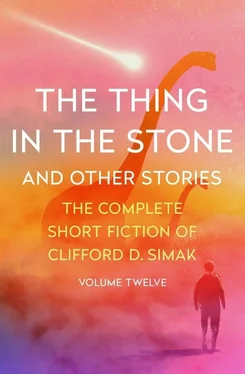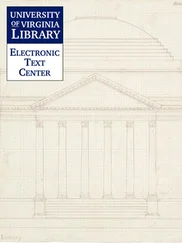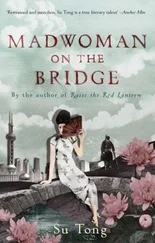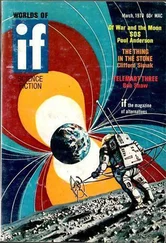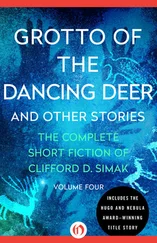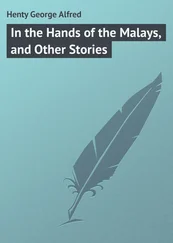“It’s harder than a bitch,” he said.
The bit began to bite. A small pile of fragments built up around the hole. The surface was hard, no doubt of that. The bit didn’t go too deep and the pile of fragments was small.
Tyler gave up. He lifted out the bit and snubbed off the motor.
“Enough for analysis?” he asked.
“Should be,” said Orson. He took the bit from Tyler and handed him a small specimen bag. Tyler laid the open mouth of the bag on the surface and brushed the fragments into it.
“Now we’ll know,” he said. “Now we will know something.”
A couple of hours later, back in the ship, we knew.
“I have it,” Orson said, “but I don’t believe it.”
“Metal?” asked Tyler.
“Sure, metal. But not the kind you have in mind. It’s steel.”
“Steel?” I said, horrified. “It can’t be. Steel’s no natural metal. It’s manufactured.”
“Iron,” said Orson. “Nickel. Molybdenum, vanadium, chromium. That works out to steel. I don’t know as much about steel as I should. But it’s steel—a good steel. Corrosion resistant, tough, strong.”
“Maybe just the platform for the structures,” I said. “Maybe a pad of steel to support them. We took the specimen close to one of them.”
“Let’s find out,” said Tyler.
We opened up the garage and ran down the ramp and got out the buggy. Before we left we turned off the television camera. By this time Moon Base would have seen all they needed to see and if they wanted more they could ask for it. We had given them a report on everything we had found—all except the steel surface and the three of us agreed that until we knew more about that we would not say anything. It would be a while in any case until we got an answer from them. The time lag to Earth was about sixty hours each way.
We went out ten miles and took a boring sample and came back, following the thin tracks the buggy made in the dust, taking samples every mile. We got the answer that I think all of us expected we would get, but couldn’t bring ourselves to talk about. The samples all were steel.
It didn’t seem possible, of course, and it took us a while to digest the fact, but finally we admitted that on the basis of best evidence Pluto was no planet, but a fabricated metal ball, small-planet size. But Godawful big for anyone to build.
Anyone?
That was the question that now haunted us. Who had built it? Perhaps more important—why had they built it? For some purpose, surely, but why, once that purpose had been fulfilled (if, in fact, it had been fulfilled) had Pluto been left out here at the solar system’s rim?
“No one from the system,” Tyler said. “There’s no one but us. Mars has life, of course, but primitive life. It got a start there and hung on and that was all. Venus is too hot. Mercury is too close to the sun. The big gas giants? Maybe, but not the kind of life that would build a thing like this. It had to be something from outside.”
“How about the fifth planet?” suggested Orson.
“There probably never was a fifth planet,” I said. “The material for it may have been there, but the planet never formed. By all the rules of celestial mechanics there should have been a planet between Mars and Jupiter, but something went haywire.”
“The tenth planet, then,” said Orson.
“No one is really positive there is a tenth,” said Tyler.
“Yeah, you’re right,” said Orson. “Even if there were it would be a poor bet for life, let alone intelligence.”
“So that leaves us with outsiders,” said Tyler.
“And a long time ago,” said Orson.
“Why do you say that?”
“The dust. There isn’t much dust in the universe.”
“And no one knows what it is. There is the dirty ice theory.”
“I see what you’re getting at. But it needn’t be ice. Nor graphite nor any of the other things that have been—”
“You mean it’s that stuff out there.”
“It could be. What do you think, Howard?”
“I can’t be sure,” I said. “The only thing I know is that it couldn’t be erosive.”
Before we went to sleep we tried to fix up a report to beam back to Moon Base, but anything we put together sounded too silly and unbelievable. So we gave up. We’d have to tell them some time, but we could wait.
When we awoke we had a bite to eat, then got into our suits and went out to look over the structures. They still didn’t make much sense, especially all the crazy contraptions that were fastened on the ribs and struts and braces. Nor did the scooped-out hollows.
“If they were only up on legs,” said Orson, “they could be used as chairs.”
“But not very comfortable,” said Tyler.
“If you tilted them a bit,” said Orson. But that didn’t figure either. They would still be uncomfortable. I wondered why he thought of them as chairs. They didn’t look like any chairs to me.
We pottered around a lot, not getting anywhere. We looked the structures over inch by inch, wondering all the while if there was something we had missed. But there didn’t seem to be.
Now comes the funny part of it. I don’t know why we did it—out of sheer desperation, maybe. But failing to find any clues, we got down on our hands and knees, dusting at the surface with our hands. What we hoped to find, I don’t know. It was slow going and it was a dirty business, with the dust tending to stick to us.
“If we’d only brought some brooms along,” said Orson.
But we had no brooms. Who in his right mind would have thought we would want to sweep a planet?
So there we were. We had what appeared to be a manufactured planet and we had some stupid structures for which we could deduce not a single reason. We had come a long ways and we had been expected to make some tremendous discovery once we landed. We had made a discovery, all right, but it didn’t mean a thing.
We finally gave up with the sweeping business and stood there, scuffing our feet and wondering what to do next when Tyler suddenly let out a yell and pointed at a place on the surface where his boots had kicked away the dust.
We all bent to look at what he had found. We saw three holes in the surface, each an inch or so across and some three inches deep, placed in a triangle and close together. Tyler got down on his hands and knees and shone his light down into the holes, each one of them in turn.
Finally he stood up. “I don’t know,” he said. “They could maybe be a lock of some sort. Like a combination. There are little notches on the sides, down at the bottom of them. If you moved those notches just right something might happen.”
“Might blow ourselves up, maybe,” said Orson. “Do it wrong and bang!”
“I don’t think so,” said Tyler. “I don’t think it’s anything like that. I don’t say it’s a lock, either. But I don’t think it’s a bomb. Why should they boobytrap a thing like this?”
“You can’t tell what they might have done,” I said. “We don’t know what kind of things they were or why they were here.”
Tyler didn’t answer. He got down again and began carefully dusting the surface, shining his light on it while he dusted. We didn’t have anything else to do, so helped him.
It was Orson who found it this time—a hairline crack you had to hold your face down close to the surface to see. Having found it, we did some more dusting and worried it out. The hairline described a circle and the three holes were set inside and to one edge of it. The circle was three feet or so in diameter.
“Either of you guys good at picking locks?” asked Tyler.
Neither of us were.
“It’s got to be a hatch of some sort,” Orson said. “This metal ball we’re standing on has to be a hollow ball. If it weren’t its mass would be greater than it is.”
Читать дальше
